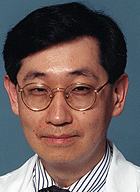Diagnosing acute stroke is a high-pressure decision. The speed with which treatment is delivered makes all the difference. Early treatment can stop brain damage, but, if treatment is given inappropriately, it can dangerously increase the risk of bleeding in the brain.

Lee
Because of this risk, the final decision to administer stroke treatment — a clot-busting enzyme known as tissue plasminogen activator (tPA) — is usually reserved for neurologists or, in some cases, other attending physicians. But now a study conducted by School of Medicine researchers with neurology residents at Barnes-Jewish Hospital has shown that residents with appropriate training can safely make the call, ensuring that effective treatment is delivered faster.
“Door-to-needle” times, measured as the time between a patient’s arrival and the administration of tPA, were reduced by 26 percent, from an average of 81 minutes to 60 minutes.
“What’s critical here is ability to safely reduce ‘door-to-needle’ time without unnecessarily increasing the risk of a brain hemorrhage,” said Jin-Moo Lee, M.D., Ph.D., associate professor of neurology and director of the Cerebrovascular Disease Section in the Department of Neurology. “What we’ve shown is that with proper training, feedback and supervision, residents are more than capable of making this complex decision safely.”
The study appears online in the journal Stroke.
Although they have completed medical school and passed the license exams necessary to practice general medicine, residents are working in hospitals to undertake more advanced postgraduate training. A select group of critical life-and-death treatment decisions traditionally has been reserved only for physicians who have completed their residencies.
Stroke treatment is one such decision. At academic and community medical centers, it is usually held for specialists in neurology, or, in some cases, emergency medicine. But while residents are almost always immediately available in the emergency room, neurologists may not be, and the time spent waiting for such a physician to be summoned can allow harm from the stroke to intensify and spread.
For the study, which began in 2004, neurology residents at Barnes-Jewish Hospital started taking an annual mini-course on the use of tPA. The course taught them how to appropriately choose candidates for tPA and how to administer it. After residents were given the authority to administer tPA, a committee of medical faculty and staff met monthly to review the case of every patient evaluated for stroke treatment, giving residents feedback on their decision-making.
Researchers assessed the results by comparing the outcomes and complications of stroke patients treated by residents from 2004- 2007 against the same data for stroke patients treated by attending physicians and fellows from 1998- 2002. There was no significant increase in negative outcomes, including bleeding in the brain, and door-to-needle times were notably shorter for patients treated by residents.
“It makes sense — residents are always in-house, and if they can make a direct decision on treatment without waiting for an attending or a fellow to respond to a pager, then the treatment time is going to be shorter,” said lead author Andria Ford, M.D., instructor in neurology and a neurologist at Barnes-Jewish Hospital.
Neurology residents at Barnes-Jewish Hospital continue to regularly train in tPA usage and to have the authority to administer tPA. Given an academic medical center where the resources exist to expand resident training and provide regular feedback, Lee said he thinks the model can be applied “across the board — not just to neurologists-in-training but to emergency department physicians-in-training, for example.”
Lee characterizes the study as the culmination of two major branches of the work of senior author Abdullah Nassief, M.D., a stroke expert who died suddenly of coronary artery disease Feb. 3.
“Dr. Nassief was both director of the neurology department’s residency program and of the Clinical Stroke Center and acute rehabilitation program at Barnes-Jewish Hospital, so he was very interested in the residents and in stroke treatment,” Lee said. “In this last paper, he let the resident physicians teach the attending physicians a lesson: that with the proper training, they can make these complex decisions as well as the attendings.”